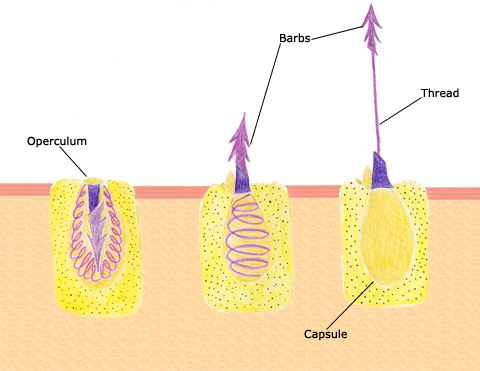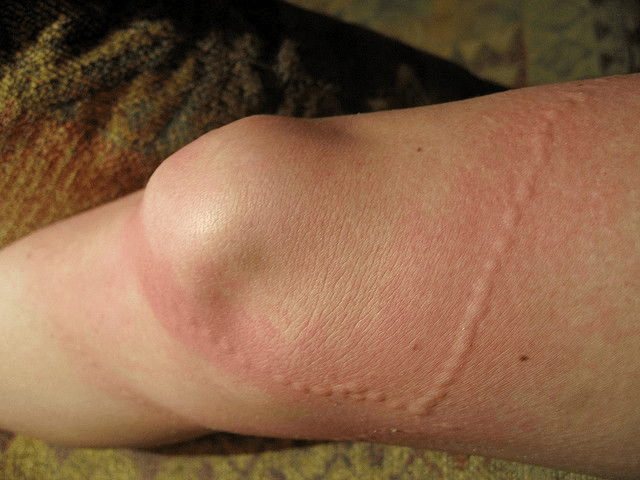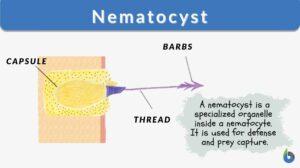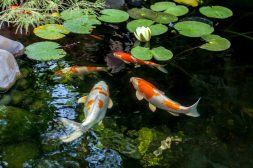
Nematocyst
n., plural: nematocysts
[ˈnɛm ə təˌsɪst,]
Definition: Inside a nematocyte is a special organelle containing coiled, hollow tube used for defense and prey capture
Table of Contents
All organisms are composed of millions of cells. Many cells serve specific purposes and are specialized to do distinct activities. There are various specialized cells, such as red blood cells in the body that are responsible for carrying oxygen molecules and cnidarian nematocysts. What are nematocysts? How can one define nematocyst? Is a nematocyst a cell? Let’s find out!
Nematocyst Definition
First, let us talk about cnidae. Cnidae (singular: cnida) are capsule-like organelles with eversible tubules (similar to that of stomach eversion in sharks, they shoot the tubule outwards). They are the phylum’s distinguishing trait; Cnidae are present in all cnidarians — no loss of the trait is known. There are three primary forms of cnidae, with various variations:
- Nematocysts
- Ptychocysts
- Spirocysts
The nematocyte is a specialized cell in a jellyfish’s or other coelenterate’s tentacles that contains the nematocyst, the secretory organelle in a form of a capsule with a barbed or venomous coiled thread that may be discharged in self-defense or to catch prey. A nematocyst diagram can be seen in Figure 1 below.

In cnidarians, nematocysts are important in the action of locomotion as well as prey capturing and defense mechanisms. These are seen in jellyfish nematocysts and many others.
Ptychosysts are cnidae that secrete a sticky substance used to hold on to prey. Spirocysts, in turn, fire lasso-like strings that are used to wrap around prey.
There are two main locations of nematocysts in organisms. Nematocyst cells may be found throughout the mouth and tentacles, and they are employed to immobilize prey by releasing venom. They have coiled threads that may contain barbs.
On the body’s surface, there are numerous such capsules. Each is formed by a cnidoblast and includes a coiled, hollow, generally barbed thread that swiftly rotates outward (i.e., is everted) from the capsule when stimulated. The thread’s function, which typically includes venom, is to fend off attackers or capture prey.

When aroused by chemical or mechanical stimuli, a lid-like structure on the capsule’s top bursts away, and the thread everts explosively with a twisting action. The barbs operate like a drill as eversion and twisting progress, piercing (and drawing the thread into) the foreign item. If venom is present, it flows through the hollow thread, permeating the victim’s tissues and paralyzing them.
The thread splits from the nematocyst after eversion. Some nematocyst threads catch little animals by looping around them. The stinging action of nematocysts in the Portuguese man-of-war and various jellyfish species on humans can be excruciatingly painful, causing paralysis, shock, and even death.
A nematocyst is a capsular structure containing a coiled, hollow tube, and is found within the nematocyte. Nematocytes are specialized cells found in the tentacles of Cnidarians (e.g. jellyfish, hydrass, sea anemones, etc.). Each cell contains a large secretory organelle (capsule) called a nematocyst. Inside the capsule is a thread-like, coiled, hollow tube with toxic barbs. This tube is everted from the capsule to deliver a paralyzing sting to the target prey or enemies. Thus, nematocysts are chiefly for food gathering and defense mechanisms of Cnidarians.
Etymology: Greek nēmat- (thread) + cyst.
Synonym: cnidocyst.
Nematocysts Function
Which two functions do nematocysts perform? Nematocysts are responsible for prey acquisition and defense; They are also used for mobility. Despite considerable differences in size and appearance, nematocysts share a basic structure that consists of a cylindrical capsule to which a long hollow thread is linked. In certain nematocysts, the thread is inverted and coiled within the capsule, and it may be equipped with spines.
What causes nematocysts to discharge? Electrostatic repulsion, osmotic pressure generation, and conformational change at the inner tubule’s surface are the three driving factors involved in nematocyst discharge, all of which come from a loss of protons. However, the influence of these several factors may change depending on the type of cyst.
The thread is ejected from within the capsule matrix in a harpoon-like form during nematocyst discharge in response to chemical or mechanical stimulation. This process is one of the quickest in biology, and it is accompanied by the release of toxins that may be damaging to people as well.

How often can the mechanism in the nematocyst be triggered? The nematocyst can only be triggered once and since the nematocyst can only be ejected once, stinging is an energetically costly and presumably closely controlled operation. To trigger nematocyte discharge, both chemical and mechanical (chemo-tactile) stimuli must be delivered at the same time.
Electrical stimulation of nematocytes increases the likelihood of discharge in a calcium (Ca2+)-dependent manner, but direct recordings from nematocytes are limited, so mechanisms by which environmental signals control discharge are not well understood.
Types of Cnidae
Apart from nematocysts, there are other types of cnidae. They are categorized into the following groups:
- Penetrant or stenotele, is the largest and, as a result, the most complicated of the nematocysts. Once released, it penetrates the prey’s surface or chitinous exoskeleton and injects a venomous substance known as hypnotoxin, which either paralyzes or kills the victim.
- Glutinant nematocysts have a sticky coating, e.g., ptychocysts
- Volvent or the desmoneme, is a nematocyst with a pear form containing a lasso-string that is fired to wrap around the prey, e.g., spirocysts

Answer the quiz below to check what you have learned so far about nematocysts.
References
- Berking, S., & Herrmann, K. (2006). Formation and discharge of nematocysts is controlled by a proton gradient across the cyst membrane. Helgoland Marine Research, 60(3), 180–188. https://doi.org/10.1007/s10152-005-0019-y
- Figure I. Basic types of nematocyst. Intact and discharged capsules are… (n.d.). ResearchGate. Retrieved April 11, 2022, from https://www.researchgate.net/figure/Basic-types-of-nematocyst-Intact-and-discharged-capsules-are-shown-for-each-type-The_fig2_23145371
Hessinger D.A. & Lenhoff H.M. (eds) 1988. The biology of nematocysts. San Diego: Academic Press.
Nematocyst | biology | Britannica. (n.d.). Retrieved April 11, 2022, from https://www.britannica.com/science/nematocyst - Nematocyst—Structure, Function, Types and FAQs. (n.d.-a). Retrieved April 11, 2022, from https://www.vedantu.com/biology/nematocyst
- Nematocyst—Structure, Function, Types and FAQs. (n.d.-b). Retrieved April 11, 2022, from https://www.vedantu.com/biology/nematocyst
- Weir, K., Dupre, C., van Giesen, L., Lee, A. S.-Y., & Bellono, N. W. (2020). A molecular filter for the cnidarian stinging response. ELife, 9, e57578. https://doi.org/10.7554/eLife.57578
©BiologyOnline.com. Content provided and moderated by Biology Online Editors.








